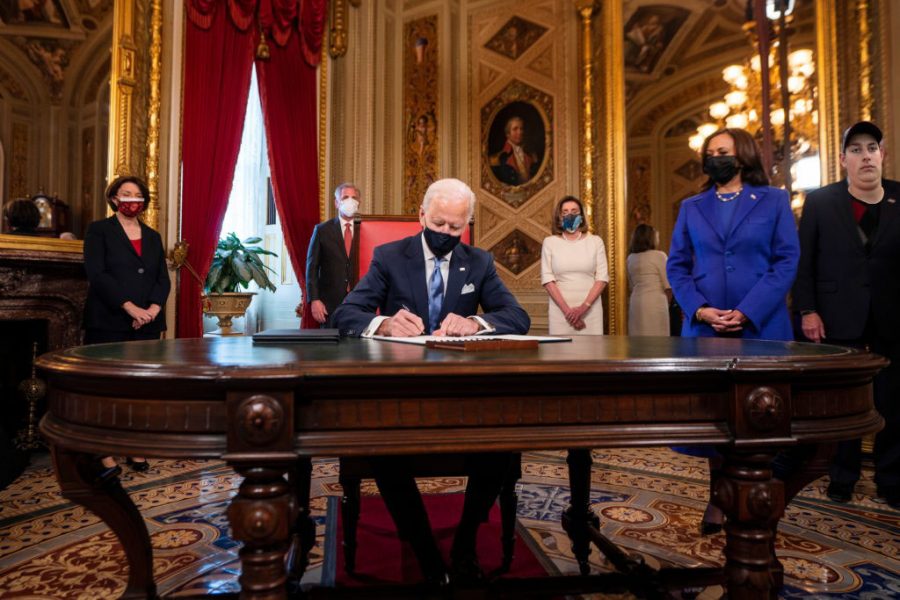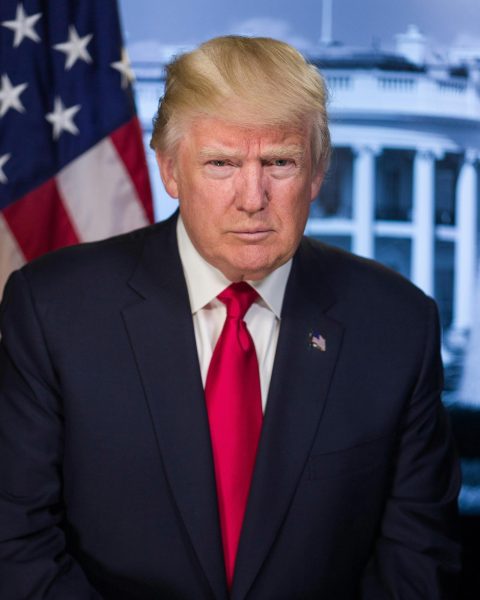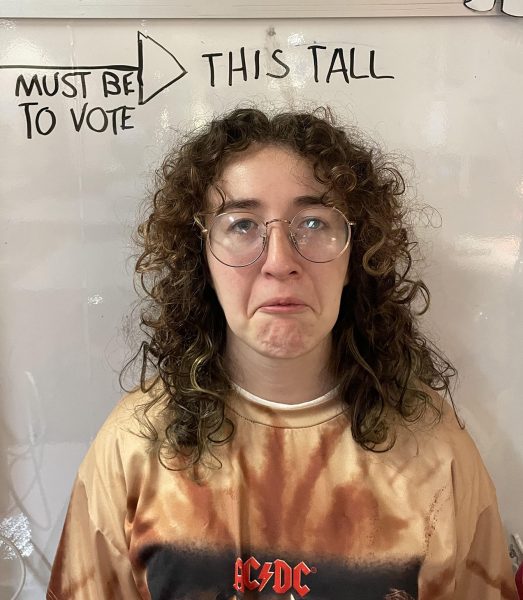Biden’s Executive Business
U.S. President Joe Biden signs three documents including an Inauguration declaration, cabinet nominations and sub-cabinet nominations, as U.S. Vice President Kamala Harris watches in the Presidents Room at the U.S. Capitol after the 59th Presidential Inauguration in Washington, U.S., January 20, 2021. Jim Lo Scalzo/Pool via REUTERS
With the Biden presidency being in its infancy, that doesn’t mean that there has been a lack of political events. President Biden has used his powers so far to get a historically large amount of work done. In his first two weeks in office, President Biden has signed 28 executive orders, which is more than any President in that time frame. President Biden was only two executive orders off equaling President Franklin D. Roosevelt’s entire first month of executive orders which was historic in its own right. For those that don’t know what an Executive Order is it is effectively the President directing parts of the Executive Branch to enforce laws and allocate resources in a certain way.
With all of the executive orders and other political actions happening so rapidly, here is a basic breakdown of some of the more major policies to hopefully get you up to speed.
COVID-19
Order coordinating a Government-wide COVID-19 response: this order is intended to create a larger effort for the federal government to have a united message and strategy to fight COVID-19.
Order establishing a COVID-19 Health Equity Task Force: providing recommendations on the allocation of resources due to “disparities in COVID-19 outcomes by race, ethnicity and other factors.”
Order expanding COVID-19 Treatments: Secretary of Health is to support research into different treatments for COVID, and support long term care facilities and nursing homes
Order supporting reopening of schools: Department of Health and Human Services is to guide schools in reopen and operating safely
Environmental Issues
Rejoining the Paris Climate Accord: This was originally signed in 2015 by President Obama to combat climate change, but President Trump officially left the agreement late last year. This is a signal that President Biden is taking climate change seriously as a major point of his policy decisions.
Cancelation of the Keystone XL Pipeline: the revocation of this permit for the construction of the crude oil pipeline that connected Hardisty, Alberta to Steele City, Nebraska was a major signal in support of environmental issues. This has been one of the more controversial policy moves so far. Not only has this been met with opposition from Republicans, but the United Association of Union Plumbers and Pipefitters, who endorsed Biden, has come out in opposition to this move.
Immigration and Border Policy
Ending of the ban on the travel ban implemented by The Trump Presidency: this order ends the travel bans that President Trump put in place that banned citizens of Iran, Iraq, Somalia, Syria, Yemen, Chad, North Korea, and Venezuela.
Order revisiting Immigration Policy: revokes a Trump Executive Order that held federal
grants from sanctuary cities.
Order that includes undocumented immigrants in the Census: this order says that undocumented immigrants will be counted in the census count. This is a counter to President Trump’s attempts to not include undocumented immigrants from being counted last year.
Revocation of funds from Border Wall: this ends the construction of the border wall and pulls all funding from the wall. The wall was one of President Trump’s biggest campaign points when running in 2016
Strengthening DACA: DACA was one of the major victories in the Obama administration. President Trump attempted to end the program that protected undocumented immigrants that arrived in the U.S. as children.
Economic Policy
Order empowering federal workers and contractors: makes it harder to fire civil servants and ordered the Labor Department to recommend all federal government employees receive a $15 minimum wage.
Health Care Policy
Order reinforcing Medicaid and the Affordable Care Act: an examination of policy from the previous administration’s on health care
Revocation of the “Mexico City Policy”: this gets rid of a policy that blocked federal funding for foreign organizations that perform abortions and provide abortion counseling.
Racial Justice Issues
Order to Promote Racial Equity: agencies to perform an assessment to “advance equity for all, including people of color and others who have been historically underserved, marginalized and adversely affected by persistent poverty and inequality.”
As you can see by the sheer quantity of executive orders, Joe Biden has gotten to work and then some. With congress effectively at gridlock on any piece of legislation, it can be expected that President Biden will use the power of Executive Orders to its fullest.
Mr. Zebrine Interview
- Why is the first 100 days of a Presidency so important?
Mr. Zebrine: The First 100 Days is critical for several reasons. First and foremost, it signals to your supporters that you see their election of you as a mandate, and that you are willing to pursue the policies on which your campaign was premised. It also has a historical reference to the actions of former Democrat President Franklin D. Roosevelt, who proclaimed the use of his first 100 days to take bold actions for the nation during the depths of the Great Depression. It’s important to understand that President Biden secured the greatest number of popular votes (over 80 million) in American history. Many of his supporters expect action on a large number of items, so he has to signal from the start that he is delivering.
- What were your reactions to the first few major policy decisions? (Keystone pipeline, Paris Climate Accord)
Mr. Zebrine: President Biden presides over a Democrat Party that has many different constituencies within it, including conservative, moderate, and liberal factions. As the de facto leader of the Party, he has to signal that he is addressing concerns from each wing of the Party. Stopping construction of the Keystone Pipeline, while not without controversy, pleases the environmentalist constituency of the Party. Less costly to the president but pleasing this same group was his rejoining the Paris Climate Accords, which is voluntary and does not require a Senate confirmation as a normal treaty would require.
- How do you think the split Senate will affect the administration’s goals?
Mr. Zebrine: The current party breakdown in the Senate will mean that President Biden will have a very narrow path to advance legislation. Even though Democrats nominally control the Senate, President Biden will need to advance legislation that pleases the moderates and conservatives of his party, in order to avoid defections to the Republican side. I think his campaign rhetoric and past experiences as a senator suggest he can and will do this. At the same time, if he faces obstructionist tactics from Republicans on critical pieces of legislation, I do not think he will hesitate to rely on his Party’s slim majority. He just has to be thoughtful on what he is willing to negotiate, and what legislative priorities are non-negotiable.
- With the gridlocked congress do you think executives will take a larger role?
Mr. Zebrine: Executive Orders have been used increasingly over the past few decades, and I expect this to continue under the Biden Administration. Already we have seen a slew of orders, and this is reflective of the political gridlock we have unfortunately become accustomed to within our Congress. That said, Executive Orders are not the same as lawmaking, and they can only take the administration so far.
- What do you expect policywise in the future from the Biden Administration?
Mr. Zebrine: In terms of policy priorities, I expect President Biden to pursue what he campaigned on – namely, addressing what he believed were the nation’s pressing problems: tackling the COVID-19 pandemic and its effects; engaging in more robust protection of the environment; addressing dysfunction within the American economy; and addressing systemic racism. I think in terms of rhetoric and style, we will see a continuing effort by President Biden to unify Americans after a very contentious election cycle and a most difficult year in 2020, and engage in bipartisanship when possible. Whether he can do that or not is an open question. I think that in the realm of foreign policy – and you can already see the beginnings of this – we will see a return to America’s international role of promoting peace initiatives, utilizing multilateral efforts to combat the world’s problems, and promoting democratic institutions around the world. I think we are already witnessing an effort by the Biden Administration to rebuild our democratic institutions within the federal government, including at the State Department. Part of this effort is by keeping career diplomats and staffers at their jobs, or bringing them back if they left under the previous administration. I think we already see President Biden pushing back against irresponsible and meddling behavior by Russia, while still keeping the door open to resuming a nuclear arms control treaty that had been allowed to lapse under former President Trump.
- Is there anything else you would like to add?
Mr. Zebrine: One of the things that will be interesting to watch is whether the Democrat Party is returning to its traditional role of promoting the interests of the working class, as it appears is the preference of President Biden. Ironically, some of the unorthodox Republican policy positions of former President Trump – calling out China for its illegal and unfair trade practices, promoting American manufacturing and fair trade, promoting the prosperity of American farmers – were once among the top priorities of the Democratic Party. It appears as if President Biden is embracing these positions to some extent, in an effort to reclaim these policies for his Party. It will be interesting to see where that embrace takes him with voters over the next few years.







